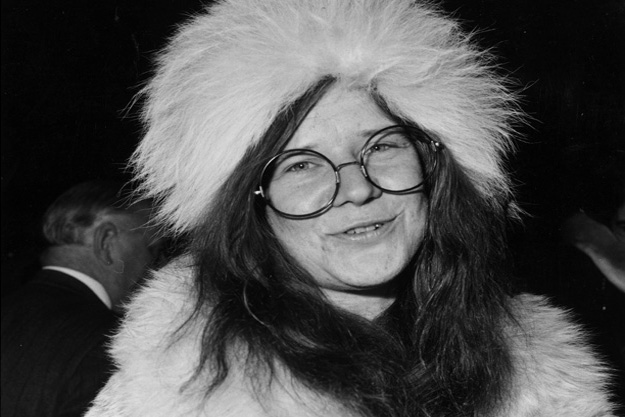Janis Joplin, often referred to as the “Queen of Rock and Roll,” is best remembered for her rebellious lifestyle, her psychedelic Porsche, her free flowing fashion sense and above all, her distinctive voice. Here are 10 things we bet you didn’t know about her:
1. She Made Certain Her Biggest Influence Got a Proper Tribute
One of Joplin’s biggest influences was blues singer Bessie Smith, who’s been hailed as ‘The Empress of the Blues.’ In 1937 Smith died from severe injuries due to a car accident and sadly was buried in an unmarked grave, where she remained until August 1970. Joplin and Juanita Green (who as a child had done housework for Smith) paid for a proper tombstone to be erected on Smith’s gravesite.
2. Her Last Recording Was a Birthday Greeting for John Lennon
The last recordings Joplin completed were ‘Mercedes-Benz’ and a birthday greeting for John Lennon. On Oct. 1, 1970, Joplin recorded the old Dale Evans cowboy tune ‘Happy Trails’ for the former Beatle, which is sort of spooky given the lyrics are “Happy trails to you, ’till we meet again.” The tune was titled ‘Happy Birthday, John (Happy Trails)’ and released on the Janis box set in 1993. Lennon told talk show host Dick Cavett that her taped greeting arrived at his home after her passing.
Do you sing? Can’t go wrong with this studio mic!
3. Her Ashes Were Scattered in the Deep Blue Sea
Joplin was cremated in the Pierce Brothers Westwood Village Mortuary in Los Angeles, Calif. Her ashes were scattered from a plane into the Pacific Ocean and along Stinson Beach. There was a private funeral service, but it was only attended by Joplin’s parents and her aunt.
4. She Was Rewarded for Repeatedly Passing Out
Joplin was a heavy drinker, and Southern Comfort was her drink of choice. The whiskey became so synonymous with the singer, and she therefore boosted the company’s sales to such an extent, that she managed to get them to give her a lynx coat as a thank-you. (This is pre-PETA, we’re guessing!)
5. She Was Getting Tattooed Long Before it Was Trendy
In April of 1970, Joplin was tattooed by legendary artist Lyle Tuttle. He inked a famous design on Janis’ outer wrist in his shop on Seventh Street in San Francisco. The symbol stands for the liberation of women. She also had a small heart tattooed over her left breast. “I wanted some decoration. See, the one on my wrist is for everybody; the one on my tit is for me and my friends.” She paused and chuckled, “Just a little treat for the boys, like icing on the cake.”
Guitar Students! Need a sweet electric?
6. ‘All Is Loneliness’ Comes Straight from Her Heart
Janis was overall a very lonely young woman in spite of all the people surrounding her. She loved men (to put it nicely) and had several lovers but in many ways was very much a loner. “Onstage, I make love to 25,000 people – then I go home alone.”
7. You Could’ve Seen Her Perform at Woodstock for $8.00
A Variety Magazine image pictured on JanisJoplin.net reveals that Joplin was to be paid $7500 for performing at Woodstock, although it’s been said that many of the performers were never paid. Do you know what it would’ve cost you to attend Woodstock? A mere $8.00 would’ve bought you admission for one day, or you could’ve been the big spender and paid $18.00 for a three day ticket.
8. Treated Billie Holiday’s Biography “Like a Bible.”
Two other people that heavily influenced Joplin were Billie Holiday and Leadbelly. Joplin has claimed that the first album she ever bought was a Leadbelly record. In regards to Holiday, one of the two books that Joplin took to San Francisco with her was Holiday’s autobiography ‘Lady Sings The Blues.’ Joplin’s friend Richard Hundgen believes it was like a Bible to her, and said that she kept it all her life.
Learning Guitar? Get your first instrument
9. ‘Cheap Thrills’ Was Originally Titled Something Else
The album ‘Cheap Thrills’ was originally supposed to be titled ‘Sex, Dope And Cheap Thrills’ but Columbia Records didn’t go for two-thirds of that. Since advocating cheap thrills didn’t threaten them as much as the other two, that became the LP’s title instead.
10. She Dissed Jim Morrison – Twice!
The Doors frontman Jim Morrison was physically turned on to Joplin after she busted a bottle of Southern Comfort over his head, knocking him out cold. Morrison, loving the physical confrontation and her violent attitude, seemed to be in love. The day after this strange encounter during rehearsals, he asked producer Paul Rothchild for her phone number. Joplin had no intent on getting together with Morrison again and as it turns out, they never did. Morrison was reportedly heartbroken









